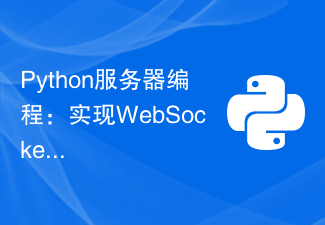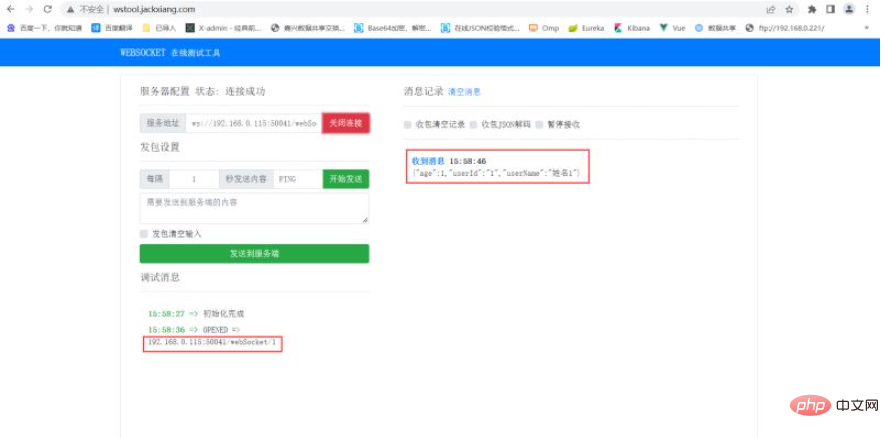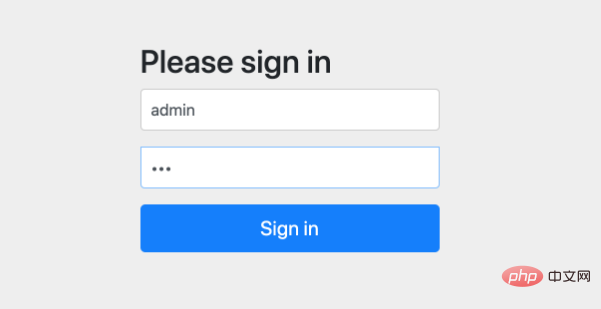1. Introduction
In order to allow the Web application to maintain two-way communication with the server process, here is the introduction of WebSocket interface.
2. Consistency requirements (omitted)
3. Terminology (omitted)
4.WebSocketInterface
(code omitted)
WebSocket(url, protocols)Constructorcan be passed in1-2 parameters. The first Rigel specifies the URL to connect to. The second parameter, if declared, can be a string or a string array . If it is a string, it is equivalent to an array containing only that string. If the second parameter is omitted, it is equivalent to an empty array [that is, no matter what is passed in the second parameter, it will be treated as a string array]. Each string in the array is a subprotocol name. The connection can only be established if the server declares that it has selected one of the subprotocols. All subprotocol names must meet the following requirements: These strings must contain the Sec-WebSocket-Protocol in the WebSocket protocol declaration header. Content①.
When the WebSocket() constructor is called, the user agent must perform the following steps:
(1) From urlParses out each component of URL to obtain the host, port, resource name and securityprotocol(host , port, resource name, and secure). If this process fails, a SyntaxError exception will be thrown and the following steps will be terminated.
(2) If secure is empty, but the original entry script has a pattern that is itself a security protocol, such as HTTPS , then throw SecurityError exception. (If secure is false but the origin of the entry script has a scheme component that is itself a secure protocol, e.g. HTTPS, then throw a SecurityError exception.)
(3) If the port used in the parameter is set to be prohibited from access by the user agent, then a SecurityError exception will be thrown. Ports 80 and 443 should not be blocked, including secure is# In the case of ##false443 port cannot be prohibited from access, secure is When true, the 80 port cannot be blocked from access [Here it means that there are two types of WebSocket In the form, ws does not have a security protocol, and the default port is 80, wss is with a security protocol, and the 443 port is used by default. However, even if the protocol used does not require a corresponding port, access to 443 cannot be prohibited. and 80 are the two ports].
(4) If theprotocols parameter is not declared, let it become an empty array. Otherwise, if the protocols parameter is a string, let it become an array containing the string.
(5) If anyvariable in the protocols parameters is declared more than this, or does not meet the requirements of ①, then Throws the SyntaxError exception and terminates the following steps.
(6)Letorigin be the ASCII serialization of the origin of the entry script, converted to ASCII lowercase.
(7)Return a newWebSocketObject, and continue to perform the following steps in the background program.
(8) Create a file containing the givenhost, port, resource name, and secure and protocols list, and an empty extensions(extensions) list and origin#WebSocketconnect. To send the correct cookies header, you must use the Cookie header, the value of which is passed by the user Calculated from the stored cookie value and url. For these purposes, this is not an API without the HTTP protocol.
During the execution of the "WebSocketEstablishing Connection Algorithm", when the user agent verifies the server's response, if the status code received from the server is not 101, the user agent must terminate this WebSocket connection.
warn! Using HTTP here may cause serious security risks to the browser context. For example, imagine a host is a server set up using WebSocket on one path, with an open HTTP redirect pointing to another path . Suddenly, any script that is specified with a specific WebSocket URL can enter this service and communicate with other hosts on the Internet, even if the script checks the URL is the correct host name.
Note: If the WebSocket connection algorithm fails to execute, the WebSocket connection failure algorithm will be triggered. This algorithm will Execute the algorithm for closing the WebSocket connection, which will close the WebSocket connection and trigger close Event, the execution steps are as described below.
When the global object of the script is a Window object or an object instantiated through the WorkerUtils interface, This constructor must be visible. The
url attribute must be parsed from the URL passed to the constructor. The
readyState attribute represents the status of the connection. It has the following values:
CONNECTING, the corresponding value is 0, indicating that the connection has not been established;
OPEN, the corresponding value is 1, indicating WebSocketThe connection has been established and communication can be carried out;
CLOSING, the corresponding value is 2, indicating that the connection is undergoing a closing handshake, or the close() method has been called;
CLOSED, the corresponding value is 3, indicating that the connection has been closed or the connection cannot be opened.
When the WebSocket instantiated object is created, its readyState value must be set to CONNESTING.
extensionsThe initial value of the attribute must be an empty string. When the WebSocket connection is established, its value can be changed according to the following rules.
Note: If the server selected the extension, the extension property returns the extension selected by the server. (Currently this field is always an empty field)
protocolAttribute initialization must be an empty string . When the WebSocket connection is established, its value can be changed according to the following rules.
Note: If the server specifies a subprotocol, the protocol attribute returns the subprotocol selected by the server.
close() The method must be executed according to the following steps:
(1) If this method passes the first parameter but it is not equal to 1000 or not within 3000 to 4999, throw InvalidAccessErrorException and terminate the following steps.
(2) If the second parameter is passed in, execute the following sub-steps:
① Let raw reason become the second parameter of the method Parameter
②( is omitted after )
(3) Execute the first matching step below
①If the readyState attribute is CLOSING or CLOSED, nothing happens .
②If the WebSocket connection has not been established, terminate the establishment of the WebSocket connection and ## The property value of #readyState is set to CLOSING.
③If the closing handshake ofWebSocket has not started, start the closing handshake of WebSocket, and readyState is set to CLOSING. If the first parameter is passed, then WebSocketThe status code used to close the message must be the integer specified by the first parameter. If the second parameter is also declared, reason must be given after the status code of the shutdown message.
④In other cases, set thereadyState attribute value to CLOSING.
The above is the detailed content of Detailed introduction to WebSocket API HTML5 specification translation. For more information, please follow other related articles on the PHP Chinese website!
 SpringBoot怎么整合WebSocket实现后端向前端发送消息May 11, 2023 pm 02:07 PM
SpringBoot怎么整合WebSocket实现后端向前端发送消息May 11, 2023 pm 02:07 PM一、什么是websocket接口使用websocket建立长连接,服务端和客户端可以互相通信,服务端只要有数据更新,就可以主动推给客户端。WebSocket使得客户端和服务器之间的数据交换变得更加简单,允许服务端主动向客户端推送数据。在WebSocketAPI中,浏览器和服务器只需要完成一次握手,两者之间就直接可以创建持久性的连接,并进行双向数据传输。在WebSocketAPI中,浏览器和服务器只需要做一个握手的动作,然后,浏览器和服务器之间就形成了一条快速通道。两者之间就直接可以数据互相传送。
 在ThinkPHP6中使用Nginx反向代理WebsocketJun 20, 2023 pm 09:31 PM
在ThinkPHP6中使用Nginx反向代理WebsocketJun 20, 2023 pm 09:31 PM在近几年的互联网应用中,Websocket已经成为了一种非常重要的通信协议。ThinkPHP6作为一款优秀的PHP开发框架,也提供了对Websocket的支持。不过,在使用Websocket时,我们通常会涉及到跨域、负载均衡等问题,因此,在这篇文章中,我们将介绍如何在ThinkPHP6中使用Nginx反向代理Websocket。首先,我们需要明确一下Webs
 Python服务器编程:实现WebSocket服务端Jun 19, 2023 am 09:51 AM
Python服务器编程:实现WebSocket服务端Jun 19, 2023 am 09:51 AM近年来,WebSocket技术日渐流行,成为了浏览器与服务器之间进行实时通信的标准选择。在Python中,我们可以通过一些成熟的库来实现WebSocket服务端的开发。本文将在介绍WebSocket技术的基础上,探索如何利用Python开发WebSocket服务端。一、什么是WebSocketWebSocket是一种在单个TCP
 SpringBoot怎么实现WebSocket即时通讯May 12, 2023 am 09:13 AM
SpringBoot怎么实现WebSocket即时通讯May 12, 2023 am 09:13 AM1、引入依赖org.springframework.bootspring-boot-starter-websocketorg.projectlomboklombokcom.alibabafastjson1.2.32、WebSocketConfig开启WebSocketpackagecom.shucha.deveiface.web.config;/***@authortqf*@Description*@Version1.0*@since2022-04-1215:35*/importorg.spri
 浏览器支持WebTransport?它能替代WebSockets?Feb 23, 2023 pm 03:36 PM
浏览器支持WebTransport?它能替代WebSockets?Feb 23, 2023 pm 03:36 PM许多应用程序,如游戏和直播等场景,需要一种机制来尽可能快地发送消息,同时可以接受无序、不可靠的数据传输方式。本机应用程序虽然可以使用原始 UDP 套接字,但这些在 Web 上不可用,因为它们缺乏加密、拥塞控制、同意发送机制(以防止 DDoS 攻击)。
 PHP+Socket系列之实现websocket聊天室Feb 02, 2023 pm 04:39 PM
PHP+Socket系列之实现websocket聊天室Feb 02, 2023 pm 04:39 PM本篇文章给大家带来了关于php+socket的相关知识,其中主要介绍了怎么使用php原生socket实现一个简易的web聊天室?感兴趣的朋友下面一起来看一下,希望对大家有帮助。
 SpringBoot中怎么使用WebSocket实现点对点消息May 16, 2023 pm 12:58 PM
SpringBoot中怎么使用WebSocket实现点对点消息May 16, 2023 pm 12:58 PM一、添加依赖,配置使用SpringSecurity里的用户。org.springframework.bootspring-boot-starter-security我们现在需要配置用户信息和权限配置。@ConfigurationpublicclassWebSecurityConfigextendsWebSecurityConfigurerAdapter{//指定密码的加密方式@SuppressWarnings("deprecation")@BeanPasswordEncode
 Spring Boot中使用WebSocket实现推送和通知功能Jun 23, 2023 am 11:47 AM
Spring Boot中使用WebSocket实现推送和通知功能Jun 23, 2023 am 11:47 AM在现代Web应用程序开发中,WebSocket是实现即时通信和实时数据传输的常用技术。SpringBoot框架提供了集成WebSocket的支持,使得开发者可以非常方便地实现推送和通知功能。本文将介绍SpringBoot中如何使用WebSocket实现推送和通知功能,并演示一个简单的实时在线聊天室的实现。创建SpringBoot项目首先,我们需要创建一


Hot AI Tools

Undresser.AI Undress
AI-powered app for creating realistic nude photos

AI Clothes Remover
Online AI tool for removing clothes from photos.

Undress AI Tool
Undress images for free

Clothoff.io
AI clothes remover

AI Hentai Generator
Generate AI Hentai for free.

Hot Article

Hot Tools

Dreamweaver Mac version
Visual web development tools

VSCode Windows 64-bit Download
A free and powerful IDE editor launched by Microsoft

MinGW - Minimalist GNU for Windows
This project is in the process of being migrated to osdn.net/projects/mingw, you can continue to follow us there. MinGW: A native Windows port of the GNU Compiler Collection (GCC), freely distributable import libraries and header files for building native Windows applications; includes extensions to the MSVC runtime to support C99 functionality. All MinGW software can run on 64-bit Windows platforms.

PhpStorm Mac version
The latest (2018.2.1) professional PHP integrated development tool

SAP NetWeaver Server Adapter for Eclipse
Integrate Eclipse with SAP NetWeaver application server.






